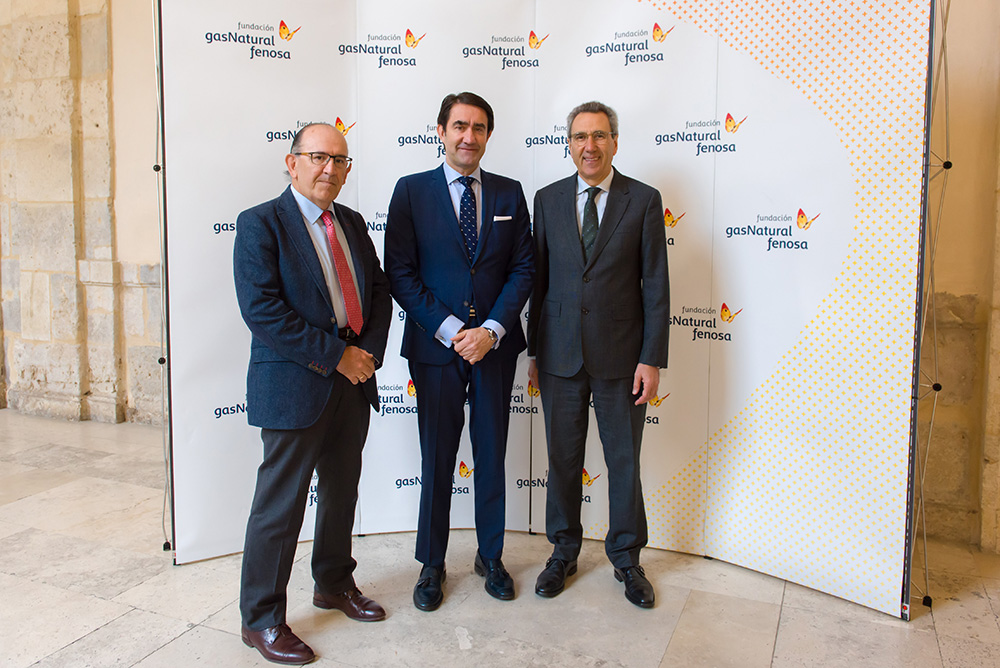Natural gas stands as an alternative efficient fuel for combating air pollution in Castile and Leon
At an event organised by the Gas Natural Fenosa Foundation in partnership with the Regional Government of Castile and Leon, various experts debated several efficient energy models in the transport sector for improving air quality in cities.
Within the framework of the seminar, the Regional Ministry of Public Works and Environmental Affairs and the Gas Natural Fenosa Foundation renewed their partnership agreement aimed at fostering awareness initiatives and encouraging energy efficiency and rational energy use.
The 2020 Castile and Leon Energy Efficiency Strategy promoted by the regional government seeks to reduce the energy consumed in the region by 32%. By applying these measures, the transport sector will reduce its CO2 emissions by 1,107,900 tonnes. This equates to the saving achieved by planting 27.7 million trees.

Earlier today, the Minister for Public Works and Environmental Affairs of the Regional Government of Castile and Leon, Juan Carlos Suárez-Quiñones, and the General Manager of the Gas Natural Fenosa Foundation, Martí Solà, officially opened the seminar entitled Vehicular Natural Gas: environmental and economic advantages at the Patio Herreriano Museum in Valladolid. At the event, which was attended by over 170 professionals, various experts debated the significant problem posed today by air pollution in our cities and the possible solutions.
The General Manager of the Gas Natural Fenosa Foundation, Martí Solà, said that “natural gas is already an efficient and affordable alternative in the transport sector when compared with other more polluting fossil fuels.” He also argued that “an energy transition requires time and resources”. Martí Solà expressed his conviction that the energy future of Spain must include “more sustainable” energies. He went on to recall that road traffic is the cause of between 40% and 65% of all air pollution.
During the opening ceremony, the Minister for Public Works and Environmental Affairs of the Regional Government of Castile and Leon explained that, although transport is a strategic asset for the social and economic development of any organised region and a fundamental factor in providing regional structure and cohesion, its development is leading to a series of negative environmental impacts and contributing to greenhouse gas emissions. For these reasons, transport has been the subject of priority attention in public policy for some time now and in an ever increasing fashion. He stressed that both these transport and energy policies seek more efficient mobility through the regulation, planning and development of transport activity in a way that meets the travel needs of people and goods while respecting the environment. To do so, we need to promote the use of alternative fuels in order to reduce air pollution and move towards a sustainable transport system. Natural gas is one of those alternative fuels.
After opening the event, Juan Carlos Suárez Quiñones and Martí Solà renewed the partnership agreement between the two organisations that fosters initiatives aimed at communicating, raising awareness and developing energy efficiency actions that seek environmental sustainability.
The importance of natural gas in urban mobility
The Head of the Energy Efficiency and Saving Department of the Regional Energy Authority (EREN), Roberto Getino de la Mano, explained the main lines of action in the 2020 Castile and Leon Energy Efficiency Strategy approved by the Regional Government of Castile and Leon.
He said that this strategy seeks “a CO2 emissions reduction of 30.24% through an investment of 86.4 million euros”. Furthermore, he recalled that the transport sector in Castile and Leon is the main energy consumer in the region and announced various lines of action aimed at improving energy efficiency there, which include the introduction of new technologies into the transport sector.
In turn, the Institutional Management CNG for SEAT, Ramón Calderón de la Fuente, stressed that “vehicular mobility with natural gas is an accessible and easily implemented sustainable alternative.” He went on to explain that, “besides being efficient from an environmental point of view, the use of natural gas as a fuel brings savings of up to 50% when compared with petrol and 30% when compared with diesel.”
The Assistant Director of the Madrid Municipal Transport Company (EMT), Juan Ángel Terrón, defended the EMT’s sustainable transport model based on natural gas buses as a success story that could be copied in other places, such as Castile and Leon. He recalled that pollution and traffic are two of the greatest concerns among the general public and that 53.7% of pollution in capital cities such as Madrid comes from road vehicles. “The main advantages of CNG stem from the significant HC, PM, NOx and CO emissions reductions (over 83% since 1994), the reduction in noise pollution and the economic benefit for the public purse.” He concluded by saying that natural gas stands as “the only real alternative to diesel”.
The Corporate Social Responsibility Manager for SEUR, May López, explained her company’s strategy for achieving carbon-neutral transportation. In turn, Beconsa Manager Paulino Benito Conde highlighted the advantages stemming from the incorporation of vehicular natural gas from the haulier perspective as a user, placing an emphasis on environmental impact reduction and fuel cost savings.
To finish, the Machinery Manager from Urbaser, Josep Compte, offered a more technical vision of compressed natural gas vehicles by present a practical case from the company, while the Professor of Environmental Engineering from Universidad Politécnica de Cataluña, José Mª Balderdash, offered a broad outlook on environmental issues stemming from the analysis contained in his various theses and publications.
Share